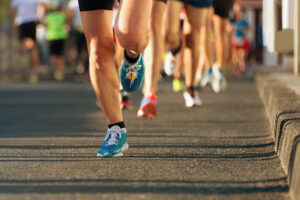
It is the time of the year when running outside becomes both popular and enjoyable. Running on the treadmill is a great way to get, and stay, fit, especially when it is dark and cold outside. But, when the mornings and evenings are light and the temperature is warm, then running outside can be a highly enjoyable.
The challenge of running outside
If you are unused to running outside, it can be a little daunting at first. Dealing with traffic, avoiding pedestrians, cyclists and other runners can be tricky. Then there is navigating your way around the streets, roads or footpaths. The important thing is to feel confident in yourself so, ahead of a run, check you know your route.
Transferring from treadmill to running outside
Once you are happy that you know where you are going, the next thing is to feel confident in yourself. While running on the treadmill is great, there are some differences once you get running in the great outdoors. A treadmill allows you to run with no breaks or alterations in your stride. Running outside means you will often have to adapt your stride as you encounter different surfaces, or turn a corner. If you are a beginner at running outside, here are some top tips for good running technique.
Look up for safety and good form
Your eyes should be focused on the ground about 10 to 15 metres ahead of you. Don’t stare at your feet. Not only is this proper running form, but it’s also a safer way to run because you can see what’s coming up ahead and avoid tripping over uneven kerbs or other obstacles.
Keep your feet pointing forwards
This sounds obvious but a lot of people run wth their feet pointing slightly outwards or inwards. This can lead to injuries and long-term, serious foot problems. Make sure your toes are pointed in the direction you want to go. If you don’t naturally run that way, it may take practice to keep your feet pointed straight. Try doing it for short distances and then increase the time or distance that you run that way. Eventually, you’ll start to get used to running with your feet pointed straight and it will feel more natural.

Pay attention to your hands
What your hands do when you run is actually very important. Try to keep your arms and hands as relaxed and loose as possible. If you tighten your hands into fists, then you will start to become tense. This will spread into your shoulders and neck, causing tightness and potential injuries.
When running outside, try to keep your hands at waist level, right about where they might lightly brush your hip. Your arms should be bent at a 90-degree angle. Some beginners have a tendency to hold their hands way up by their chest, especially as they get tired. Like clenching your fists, holding your arms unnaturally high, will lead to tension in the neck and shoulders.
Check your posture
Keep your posture straight and erect. Your head should be up, your back straight, and shoulders level. Keep your shoulders under your ears and maintain a neutral pelvis. Make sure you’re not leaning forward or back at your waist, which some runners do as they get fatigued.
Check your posture once in a while. When you’re tired at the end of your run, it’s common to slump over a little, which can lead to neck, shoulder, and lower-back pain. When you feel yourself slouching, poke your chest out.
Maintaining good form at the end of your run is important for fighting off fatigue and finishing strong.
Relax and breathe
It is important that you keep your breathing as calm and regular as possible while running outside. Your shoulders are key to this. They should be relaxed and square or facing forward, not hunched over. Rounding the shoulders too far forward tends to tighten the chest and restrict breathing. You’ll breathe a lot easier if your shoulders are relaxed.
A good programme for beginner runners is the Couch to 5k programme. This leads you through a week-by-week running programme until you are confidently knocking out five kilometres and further. Also, do speak to the staff in the Outlooks Gym as they have a wealth of knowledge about getting the most for each training session, whether it is in the gym or running outside.







